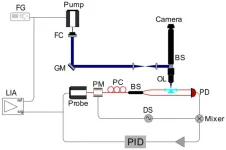(Press-News.org) A team of researchers led by Professor Sebastian Deindl at Uppsala University has developed a pioneering method that vastly improves the ability to observe and analyse complex biological processes at the single-molecule level. Their work is set to be published in the upcoming issue of the journal Science.
“With our new technique, we can now extend single-molecule biophysics to the genome scale. This advance is expected to significantly deepen our understanding of how nucleic-acid interacting proteins function in both health and disease,” says Professor Sebastian Deindl, the senior author of the study.
The method, which is called MUSCLE (MUltiplexed Single-molecule Characterization at the Library scalE), opens the door to more accurate and comprehensive studies of biological systems, where understanding the full spectrum of molecular behaviour is critical. It is expected to have a profound impact on the study of complex molecular dynamics as a function of sequence or chemical space, enabling researchers to explore previously uncharted territories in biology.
The newly developed method overcomes a significant limitation in the field of single-molecule fluorescence microscopy, which until now has been restricted by low throughput due to the laborious nature of analysing one sample at a time. Traditional approaches have been limited to studying a small number of representative samples, which could lead to biases and missed opportunities for discovering novel insights within large libraries of molecules.
MUSCLE addresses this challenge by combining the mechanistic insights from single-molecule fluorescence microscopy with the high throughput capabilities of next-generation sequencing. The workflow begins by attaching a library of fluorescently labelled molecules onto a surface known as an Illumina MiSeq flow cell. This flow cell is then placed onto a single-molecule fluorescence microscope using a 3D-printed adapter, allowing researchers to observe the real-time dynamics of individual molecules across multiple fields of view. After imaging, the flow cell is subjected to standard Illumina sequencing, which generates clusters of identical copies from the molecules previously observed. These clusters are then matched with the corresponding molecules based on their positions on the flow cell.
“Spatially registering the single-molecule imaging and Illumina sequencing data turned out to be extremely challenging, but the problem is now solved,” says Dr Anton Sabantsev, joint first author of the study.
This innovative approach allows researchers to simultaneously profile the dynamics of a vast array of samples, providing a more comprehensive understanding of complex biological processes.
“Our method allows for the direct observation of dynamic molecular behaviours across extensive libraries, significantly enhancing our ability to uncover general trends, outlier behaviours, and unique dynamic signatures that would otherwise remain hidden. It is poised to transform how we study the intricate dynamics of biomolecules, with broad applications across molecular biology, genetics and drug discovery,” says Professor Deindl.
The joint first authors of the study, Dr Javier Aguirre Rivera, Dr Guanzhong Mao, Dr Anton Sabantsev and M. Panfilov, each made significant contributions to the development and validation of this new technique.
“Key to this very challenging multi-year effort was the wonderful teamwork among our members. Everyone brought something different to the table, which was crucial for overcoming the technical hurdles we faced,” says Dr Guanzhong Mao.
The research team also included Magnus Lindell from the SciLifeLab National Genomics Infrastructure in Uppsala, whose expertise was instrumental in integrating next-generation sequencing into the MUSCLE workflow. In their initial experiments, the team applied the method to profile DNA hairpin dynamics and Cas9-induced DNA unwinding/rewinding. Their findings revealed unexpected behaviours in certain target sequences, underscoring the method’s potential to unlock new biological insights.
Given its reliance on widely available fluorescence microscopy and MiSeq instruments, along with the ease of fabricating the necessary adapter using 3D printing, the method is highly accessible to the broader scientific community. It can be adapted to study a wide range of proteins interacting with nucleic acids, as well as DNA-barcoded proteins, compounds or ligands.
END
New approach for profiling complex dynamics at the single-molecule level
2024-08-23
ELSE PRESS RELEASES FROM THIS DATE:
Single 5-nm quantum dot detection via microtoroid resonator photothermal microscopy
2024-08-23
The detection of individual particles and molecules has opened new horizons in analytical chemistry, cellular imaging, nanomaterials, and biomedical diagnostics. Traditional single-molecule detection methods rely heavily on fluorescence techniques, which require labeling of the target molecules. In contrast, photothermal microscopy has emerged as a promising label-free, non-invasive imaging technique. This method measures localized variations in the refractive index of a sample's surroundings, resulting from light absorption by sample components, which induces temperature changes in the surrounding region. Whispering ...
Alzheimer’s drug may slow down cognitive decline in dementia with Lewy bodies
2024-08-23
Dementia with Lewy bodies is a type of dementia that is similar to both Alzheimer’s disease and Parkinson’s disease but studies on long-term treatments are lacking. A new study from Karolinska Institutet in Sweden, published in Alzheimer’s & Dementia: The Journal of the Alzheimer's Association, highlights the potential cognitive benefits of cholinesterase inhibitor treatment.
Lewy body disease, which includes dementia with Lewy bodies (DLB) and Parkinson’s disease with and without dementia, is the second most common neurodegenerative disorder, following Alzheimer’s disease. DLB accounts for approximately ...
Researchers demonstrate metasurfaces that control thermal radiation in unprecedented ways
2024-08-23
NEW YORK, August 23, 2024 — In a groundbreaking advancement, researchers with the Advanced Science Research Center at the CUNY Graduate Center (CUNY ASRC) have experimentally demonstrated that metasurfaces (two-dimensional materials structured at the nanoscale) can precisely control the optical properties of thermal radiation generated within the metasurface itself. This pioneering work, published in Nature Nanotechnology, paves the way for creating custom light sources with unprecedented capabilities, ...
New images reveal global air quality trends
2024-08-23
University of Leeds News
Embargoed until 23 August 10:00 BST
A selection of AQ Stripes graphic images are available here
The global concentrations of one of the main air pollutants known to affect human health have been graphically illustrated for the first time by a team of scientists.
The Air Quality Stripes which were created by the University of Leeds, the University of Edinburgh, North Carolina State University, and the UK Met Office, starkly contrast the significant improvements in air quality across much of Europe with the alarming deterioration in parts ...
Spike mutations help SARS-CoV-2 infect the brain
2024-08-23
Still unknown what causes neurological complications of COVID-19 including ‘long COVID,’ ‘brain fog’ and loss of taste and smell
Viruses with a deletion in the spike protein are better able to infect the brains of mice
‘These findings suggest there might be treatments that could work better to clear the virus from the brain’
CHICAGO --- Scientists have discovered a mutation in SARS-CoV-2, the virus that causes COVID-19, that plays a key role in its ability to infect the central nervous system. The findings may help scientists understand its neurological symptoms and the mystery of “long COVID,” and ...
Pesco-vegetarian diets best for reducing risk of death in elderly
2024-08-23
A variety of vegetarian diets appear to protect against risk of mortality and contributing conditions, with a pesco-vegetarian diet — which includes fish — providing the most protection against risk in very elderly people, according to a new study.
Researchers at Loma Linda University Health found that vegetarian diets are associated with lower risk for all-cause mortality and many cause-specific mortalities, especially among males and in middle-aged subjects. However, slightly higher risks were observed among very elderly vegetarians for neurological conditions such as stroke, dementia, and Parkinson’s Disease. Despite this, ...
Men infected with high-risk types of HPV could struggle with fertility
2024-08-23
Cervical cancer, the fourth most common cancer type in women, causes approximately 350,000 deaths each year, mainly in middle- and low-income countries. Human papillomavirus (HPV) infection is known to cause 95% of these cases. Public health authorities in 37 countries currently vaccinate girls between nine and 14 years of age, before they typically start sexual activity.
HPV is also known to increase the risk of genital warts and cancers of the penis, anus, mouth, and throat in infected men, which is one of the reasons why the WHO and the US Center for Disease Control (CDC) ...
Scientists call for an update in environmental decision making that takes human rights into account
2024-08-23
Human wellbeing is connected to nature for food, climate regulation and culture, making the protection of nature a human rights matter.
Added to that, recent developments in international human rights law highlight that governments need to consider human-nature connections when making decisions that may affect the environment.
In a commentary published in npj Ocean Sustainability, an interdisciplinary group of researchers – including experts in ecosystem services, environmental governance, deep-sea ecology, and law – underscore that these developments should prompt a rethink of how any environmental decisions that hold the potential to impact biodiversity ...
Terahertz detection: a novel approach to real-time monitoring of perovskite ageing
2024-08-23
Hybrid perovskites have great potential for use in advanced electronic devices like solar cells and LEDs. However, one major issue holding them back is that they don't last as long as needed for widespread commercial use. As these materials age, their performance drops, which is a big problem for both researchers and companies. To tackle this issue, it's important not only to improve the stability of these perovskites but also to develop methods for detecting how they age in real-time. By understanding how these materials degrade over time, we can make them more durable and efficient.
In a recent study, researchers led by Prof. Yiwen Sun at Shenzhen University used the terahertz ...
Colorful traits in primates ease tensions between groups
2024-08-23
Primate ornamentation plays a crucial role in communication not only within social groups but also between them, according to a new study. The research reveals that the males of species with overlapping home ranges often display vibrant colors or elaborate features, traits that may help reduce intergroup aggression by enabling quick assessments of potential rivals.
Ornaments are sexually selected traits that serve as powerful signals, often indicating an individual’s genetic quality, health or physical strength. These differences ...







